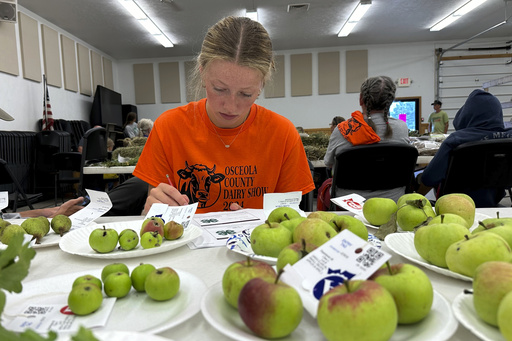Alison Smith stood in the dairy barn at the Osceola County Fairgrounds in Michigan, feeling the absence of the usual lively atmosphere that once filled the space as young participants readied their animals for competition. The recent outbreak of bird flu, now affecting mammals as well, has brought about significant changes and even cancellations to the livestock contests that are a beloved tradition at summer fairs.
Smith, a 16-year-old from Grand Rapids, had dedicated a considerable amount of time preparing her two heifers, Evergreen and Perfect, for the fair, but like many fairs across the country, the outbreak has disrupted their plans.
The bird flu outbreak has impacted millions of poultry flocks nationwide and nearly 200 dairy herds across 13 U.S. states since March, prompting states to impose stricter regulations on dairy cows. While the risk to humans from the virus remains low, it has led to losses in the industry, with businesses like Michigan’s Herbruck’s Poultry Ranch having to lay off hundreds of employees.
For Smith, who has been participating in fairs showcasing animals for a decade, the outbreak has dashed her hopes of competing for the second consecutive year. Restrictions on showing lactating cattle at fairs have added to the challenges for participants like her.
Michigan, which has been heavily affected by the outbreak, has implemented measures such as mandatory testing and public health protocols to mitigate the spread of the virus. The state ordered restrictions on exhibiting lactating dairy cattle until certain conditions are met, leading some fairs to opt for canceling events altogether.
To prevent the spread of the flu at fairs, other states like Iowa, Wisconsin, and Minnesota have introduced measures such as requiring negative flu tests for lactating dairy cows before their arrival and excluding birthing cows from exhibits. Guidance from the CDC and the U.S. Agriculture Department has emphasized testing and biosecurity measures to protect animals and people.
Fair organizers have had to adapt by introducing alternative activities like quiz bowls and photography contests in place of traditional livestock showings. While these initiatives have brought participants together, the absence of the usual competitions has left many, including Smith, longing for the familiar experience.
As Smith looks ahead to future fairs, she remains uncertain about what the coming years may hold amid the ongoing challenges posed by the bird flu outbreak. The hope is that with better understanding and preparedness, future fairs will be able to resume their traditional livestock competitions.
This website uses cookies so that we can provide you with the best user experience possible. Cookie information is stored in your browser and performs functions such as recognising you when you return to our website and helping our team to understand which sections of the website you find most interesting and useful.
